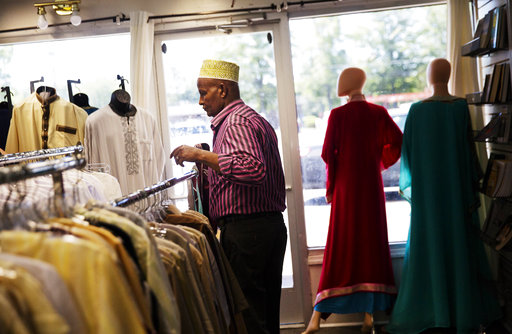AUSTIN, Texas (AP) — Somali refugee Mohamoud Saed was elated when he learned that his wife and eight children had completed the lengthy refugee application process that would allow them to join him in the U.S., reuniting the family for the first time in seven years.
But the Saeds never made the trip to the Atlanta suburbs because their travel documents expired during the legal wrangling over President Donald Trump’s executive orders to limit the refugee program and ban travel from several countries, including Somalia. They are now living in a refugee camp in Ethiopia, desperate for a permanent, peaceful home.
The family’s case illustrates how Trump’s travel bans have caused the number of refugees coming into the U.S. to plummet in the last two months, despite his executive orders largely being blocked in the courts. The number of refugees arriving in the U.S. dipped to 2,070 in March, which was a six-year low except for a period in 2013 when the federal government was shut down. The figure was slightly higher in April, 3,200, but it was still much lower than the months preceding Trump’s order.
An executive order signed by Trump in January decreased the refugee limit from 110,000 to 50,000 this fiscal year, but the cap was not blocked in court until mid-March. That caused the State Department to tightly rein in monthly arrivals when the cap was in effect.
“This program simply can’t be turned on and off like a faucet,” said Erol Kekic, executive director of the Immigration and Refugee Program for Church World Service, one of the world’s largest resettlement organizations.
Many approved refugees like the Saeds had their travel documents expire during that time, forcing them to restart the whole process and leaving them in limbo. The 56-year-old Saed, who was a doctor in Somalia before he fled the nation’s civil war, is anxiously awaiting their arrival while struggling with kidney issues that he hopes could be solved with a transplant from one of his family members.
“You can’t imagine how I’m feeling, missing my family,” Saed said.
Conservatives praise the decrease but insist a total halt in admissions is necessary. Refugee groups say the drop has forced them to lay off employees while trapping thousands of people in war-torn nations, overflowing refugee camps and dangerous living conditions amid the world’s largest refugee crisis in modern history.
At the same time, Republican-controlled legislatures have been doing their part to limit the flow of refugees into their states.
Tennessee recently followed other states in suing the federal government to ban refugees in its state, and more than a dozen states have withdrawn from the federal resettlement program.
Texas recently became the largest state to withdraw from the program, and its Legislature is now moving to abolish the state’s Office of Immigrant and Refugee Affairs. Both withdrawal from the program and abolishing the office are largely symbolic gestures, since non-profits are now tasked with coordinating refugee admissions. But state officials said they hope to put pressure on the federal government to keep its anti-resettlement fight.
“I think it would be a good idea to have a time-out on the whole resettlement program,” said Texas state Sen. Don Huffines, a Republican from Dallas who authored the bill abolishing the refugee office. “We’ve got to keep Texas safe.”
The U.S. resettlement process provides more stringent background checks than any other mode of entry in the country, and there is no evidence that refugees are more likely to commit violent acts. According to analysis conducted by the Cato Institute, a libertarian policy think tank, the chance of an American being murdered by a refugee in a terrorist attack is just 1 in 3.64 billion per year.
The legal challenges returned the refugee cap number to 110,000, but the slowdown from January to March and actions in Congress mean the U.S. will likely come nowhere close to reaching that number by the end of the fiscal year in October. The U.S. is currently on pace for about 60,000, but a State Department spokesman said the agency was “not in a position to speculate as to the final number of refugees that will be admitted by the end of Fiscal Year 2017.”
“Tickets were canceled, exit permits were canceled,” said Kay Bellor, vice president of programs for the resettlement agency Lutheran Immigration and Refugee Services. “You can’t just turn around and say, ‘everybody get back on the plane.'”
Congress has approved a budget for only 75,000 for this fiscal year. A U.S. State Department spokesman said the country is now resettling 900 refugee arrivals weekly, to remain within that budget.
And Trump can set his preferred limit for fiscal year 2018 — likely a steep drop from former President Obama’s 110,000, said Anna Greene, senior director of policy for U.S. programs with the resettlement agency International Rescue Committee.
Resettlement agencies get paid per refugee, causing them to cut back once the flow slowed down. Church World Service cut about 600 of its 640 employees in Sub-Saharan Africa but later rehired some of them, said Kekic.
Local resettlement groups around the U.S., aboard a roller coaster of fluctuating refugee admissions, have been forced to cut staff and to inform clients that relatives slated to join them in the U.S. may never arrive.
“This is one of the most challenging times that we’ve seen in refugee service,” said Aaron Rippenkroeger, president of Refugee Services Texas. “Were operating in a dramatically unstable management environment.”
___
Follow Meredith Hoffman on Twitter at https://twitter.com/merhoffman
Copyright 2017 The Associated Press. All rights reserved. This material may not be published, broadcast, rewritten or redistributed.






